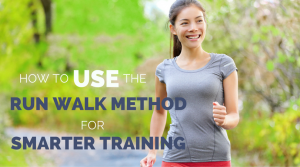As a beginner runner, training vernacular can sometimes make your head spin.
Head out on a run with your local running club or pick up the latest issue of your favorite magazine and your head is immediately filled with words such as threshold, VO2max, steady state.
Who knew running could be so complicated?
Even after you find yourself a running dictionary and figure out what these terms mean, there is still the task of understanding what they feel like.
After your research, you now understand that a tempo run means running at about 10 mile to half marathon pace, but what the heck is that supposed to feel like, especially if you’ve never run one?
But, understanding how different types of workouts should feel isn’t only important for beginner runners.
The ability to properly adjust your effort as an experienced runner is critical when you’re pushing for that last one percent improvement to breakthrough the plateau.
When you learn to comprehend exactly what certain workouts should feel like, you can easily adjust for weather conditions, workout days when you’re not on your game, and any other wrench that might get thrown into your training.
In this article, you’ll learn the purpose of three important types of workouts (steady runs, tempo runs, and VO2 max workouts) and how to properly “feel” the proper pace and effort.
Steady state or marathon pace runs
Steady runs, or marathon paces runs, are a great way to build aerobic strength, which is the foundation for your best performances from 5k to the marathon.
From a pacing perspective, steady runs are completed anywhere between 10 seconds faster and 30 seconds slower than your CURRENT FITNESS marathon pace (not your goal pace). Quite a pace range, but just another reason learning to run steady runs by feel is important.
What are the training benefits of a steady run
Running at your steady pace maximizes development of your aerobic threshold – the fastest pace you can run while still remaining completely aerobic (meaning your muscles have enough oxygen to produce all the energy they need) and while burning fat as your primary fuel source.
Developing your aerobic threshold is important because the aerobic energy system supplies more than 85 percent of the energy needed for distances of 5k or longer. The more you can develop your aerobic system over months and years of training, the faster you’ll be able to run long-term.
What does a steady run feel like
A steady run should feel “comfortably hard”. Meaning, you could keep up the pace for an hour or more, but it’s not exactly easy.
Since “comfortably hard” might mean something different to every runner, you can monitor your breathing rhythm to get a better feel for what a steady run is.
- Steady runs should typically be performed while breathing at a 3:3 ratio (three steps – one with your left, one with your right, one with your left – while breathing in; three steps – one with your left, one with your right, one with your left – while breathing out). A 3:3 breathing rhythm enables you take about 30 breaths per minute, which is needed for running “comfortably hard”.
- Another easy way to test whether you’re running in the range of steady pace is to perform what is called the “talk test”. While running, try to speak out-loud. If you can get out a three to four short sentences, but can’t quote Shakespeare, you’re running at a steady pace. If you can only blurt out one or two sentences before you start grasping for breath, you’re running too hard.
Tempo or threshold run
The tempo run is the bread and butter of most training schedules and running them at the correct effort is critical to extracting maximum benefit from the workout. From a pacing perspective, tempo runs are usually completed between 10-mile and half marathon pace, depending on the distance of the workout.
What are the training benefits of a tempo run
A tempo run, or lactate threshold run, is defined as the fastest pace you can run without generating more lactic acid than your body can utilize and reconvert back into energy.
As you learned in your quick lesson on lactic acid, your body can only “clear” or reconvert a certain about of lactic acid back into energy before the lactate floods our system and contributes to fatigue. To race faster, you must teach your body to clear lactate more efficiently.
By running just below your lactate threshold you can begin to decrease (or improve, depending on how you look at it) the pace at which you begin to produce too much lactic acid for your body to manage. This will enable you to run faster and longer before you produce more lactate than your body can clear, thus enabling you to run faster.
However, running too fast or too slow for a tempo run diminishes the benefits because you’ll either produce too much lactate quickly (by running too fast); or you’ll not produce enough lactate (running too slow) and not challenge your body.
Therefore, it’s critical that you learn how to feel what tempo pace should be.
What does a tempo run feel like
A tempo run should feel like a “hard, but controlled effort”. You should be able to continue your tempo pace for 30-45 minutes.
Again, you can use your breathing rhythm to monitor your effort.
- Tempo runs should typically be performed while breathing at a 2:2 ratio (two steps – one with your left, one with your right – while breathing in; two steps – one with your left, one with your right – while breathing out). A 2:2 breathing rhythm enables you take about 45 breaths per minute.
- Likewise, you can use the same “talk test” mentioned above to determine if you’re running in the correct effort range. During a tempo run, you should be able to say one or two sentences out-loud, but you couldn’t speak in full paragraphs or complete thoughts. Try this talk test during your next tempo run and you’ll virtually guarantee you’re in the correct effort range.
Vo2max or speed workout
VO2max and speed workouts are often a runner’s favorite training day because they’re finally allowed to run hard and push the limits. However, it’s still important for you to learn what these paces feel like so you don’t start a session of 12 x 400 meters too fast and are unable to finish strong (or at all).
From a pacing perspective, VO2max workouts are completed at 5k pace or faster.
What are the training benefits of a Vo2max workout
Defined simply, VO2 max is the maximum amount of oxygen your body can utilize during exercise. It’s a combination of how much oxygen-rich blood your heart can pump and the muscles efficiency in extracting and utilizing the oxygen.
Training at VO2max increases the amount of oxygen your body can use; the more oxygen you can use, the faster you can run.
In addition, since VO2max workouts are much faster than normal training, they force you to run more efficiently and with better form.
Developing a proper feel for VO2 max work will enable you to push yourself further during speed sessions and complete workouts strong.
What does a VO2max workout feel like
A VO2max workout will feel near maximum effort. You should be breathing very hard and only feel like you would be able to keep running for another 100 meters after you finish your interval or only be able to run one or two more intervals at the end of a workout.
- Typically, a VO2 max workout will require a very short breathing ratio to maximize the amount of oxygen to your lungs. Most runners use a 1:2 ratio (one step breathing in, two steps breathing out) or 2:1 ratio (two steps breathing in and one step breathing out) breathing rhythm. This will increase your oxygen uptake to 60 breaths per minute.
- The talk test for a VO2 max session is simple – when you start an interval you could blurt out a few words, but definitely not a full sentence. In the final half of your interval, you shouldn’t be able to talk at all.
While understanding training terminology is important, to translate these efforts appropriately to your training you need to appreciate what they feel like.
Learning to feel the proper pace in training isn’t just for beginners.
Too many experienced runners neglect what their body is telling them and are driven by the numbers on their Garmin, which often results in overtraining and not getting the most bang for your buck from a workout.
In addition, experienced and beginner runners alike can use the information about how a certain workout should feel to adjust their training for hot summer weather, hilly courses, and bad training days.
Learn to listen to your body and train smarter this summer.





7 Responses
Great article Jeff – I have a question related to the last part of the post regarding how workouts should feel…I understand (or at least I think I do) how hot conditions or hills can impact what the “right” pace is for a given workout, but I am still a little unsure as to how to deal with when your body feels tired but nothing external really changes the workout expectations…I am talking about the days where you’re just kind of dragging – maybe it’s a lack of sleep, or extra stress in non-running life, or maybe just a relatively tough stretch of training – when your body feels tired, or hitting your target paces is tougher than it usually is or should be, does that mean back off? To be a little more specific – let’s say you usually run tempo at 7:00 pace, but on your first mile you’re laboring more than you should be to hit 7:00 (using talk test or breathing rhythm mentioned above) – do you re-adjust your paces at this point and run 7:20 for the rest of the tempo, or do you push it harder than usual for a tempo effort to still run 7:00 (again, assuming heat / hills / wind is not a factor)? If this becomes a chronic issue, I know/suspect it’s probably fatigue or perhaps over-training, so my question is more about one-off days than a series of bad workouts…although your perspective on both cases would certainly be welcomed 🙂
…And I guess your other article titled “What to do when a workout isn’t going well” (referenced above as “bad training days”) kind of answers my question…so I guess the answer seems to be either slow the pace or just scrap the workout? Does that mean it never makes sense to kind of just muscle through it?
Hey Brent, great question and glad you stumbled onto the other article that helps answer it a bit. One thing I forgot to mention about running workouts by feel is that it is a great way to judge if you’re over doing it or not fully recovered between sessions.
To answer your second question, I think it comes down to where you’re at in the training cycle and your training history.
If it’s early in the segment and you’re still trying to build up the fitness, pushing through is what you want to do – even if that means you’re working much harder than you should. As you get close to the actual race, the workouts should be more in-line with the proper effort. Of course, some hard track sessions as you get close to the race are meant to be all-out effort, so it works out either way.
The second issue is your training experience and history. If you’ve suffered from overtraining before or you know that digging deep causes you to miss a weeks worth of workouts, it’s better to stop. A lot of this just comes with more and more experience running and learning your body.
Hope that helped.
That was very helpful – thanks a lot Jeff!
Hi, I am running with the free half marathon plan under 2:15 from runkeeper (and I love it), however the plan recommended pace feels too slow (I always end up running much faster than prescribed).
After reading this article I tried the speaking and step counting test and my steady pace and tempo pace are faster than what is in my plan. So, my question is: Is it okay to keep running by how I feel it or should I force myself to slow it down and follow the pace in the plan?
Thank you.
You’re probably already fitter than 2:15. Getting your paces right is important. I’d do a test to see what your fitness is and then you can target a more accurate goal. Here’s a webinar we’re doing on this: http://www.tradewithpat.com/personal-coaching-signup/
Thanks for the reply Jeff. I looked on your webinar, and read a couple of articles and did some experimenting.
I found that my steady run based on breathing 3:3 is in the range 8:30 to 9:00 min/mile. My tempo run was within 7:30 to 8:00 mile/min (breathing 2:2). That corresponds nicely with numbers that I got from your Long run pace calculator (the Race Predictor numbers) after putting in time from one of my recent workouts (8km – 38:40).
Here comes the hard part – I am trying to adjust my training properly to what I found and I’d like to clarify a few more things:
1. Do I understand it right that slow run is not the same as steady run?
2. Your calculator gives me the a) Race prediction pace and b) Long run pace. If I use the calculated pace from a) my test run pace matches the above article recommendations for steady and tempo run pace, but not with b) because it is slower. So that leads me to believe that I should take the race predictor as my goal pace, is that correct? Then, what for is the Long run pace?
3. I am thinking to adjust my pace according to what I found and keep running with the Sub 2:15 half marathon plan. What do you think about that?
Thanks a lot.